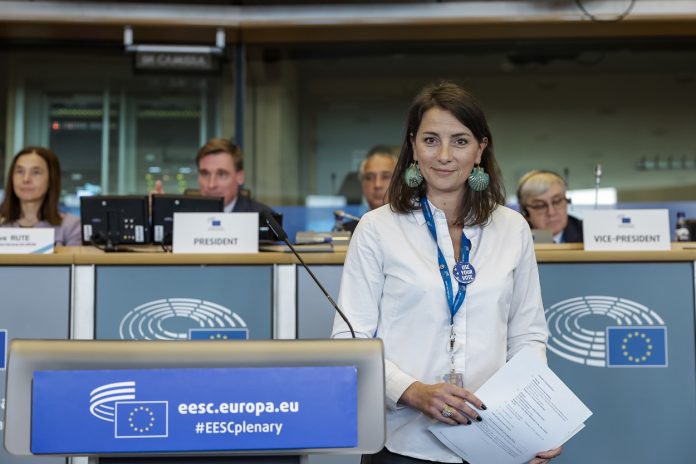Émilie Prouzet, Rapporteur for the EESC opinion on the Long-term competitiveness strategy, states the case to relaunch the European internal market and improve the EU’s long-term competitiveness
The European internal market has been in place for over 30 years and is one of the European Union’s (EU) main assets in terms of competitiveness.
The European Economic and Social Committee (EESC) has already written extensively on this milestone and the EU’s long-term competitiveness from now until 2030 – particularly on its decline.
The euro area’s GDP
Despite being the world’s leading market with a positive trade balance and recognised for the quality of its infrastructure, education system and capacity for innovation, the EU now ranks third in the world in terms of wealth produced. (1) 15 years ago, the euro area’s economy rivalled that of the United States (U.S.).
Today, the euro area’s GDP stands at just 57% of its U.S. counterpart, with no signs of catching up in the short term.
Last year, U.S. growth was five times higher than European growth. The OECD projects a 2.1% growth in the U.S., compared to 0.6% in the euro area. This same trend can also be seen on the investment side: the investment rate is expected to increase by 2% in the U.S. and by more than 3% in China, while in the euro area, it is expected to increase by just 0.3% in 2024.
Additionally, our energy costs are four times higher than in the U.S., and we remain highly dependent on certain sectors, such as the semiconductor, critical material, and medicine sectors.
The EU’s long-term competitiveness
For this reason, when it comes to the EU’s long-term competitiveness, we felt it appropriate to reposition the concept within a broader framework and work on the competitiveness ecosystem. In one of its communications, the Commission has drawn up a list of 17 performance indicators to be assessed annually in relation to the nine drivers of competitiveness that it has identified. We aimed to clarify or reposition some of these. First of all, the need to take steps to take regional circumstances into account when assessing issues and solutions seems to be a crucial angle that the Commission has not adequately addressed.
Regarding the indicators concerned, we will mention the following:
- Access to finance:
- It is essential that this comes at a reasonable cost, but not to the detriment of future generations.
- Public services and critical infrastructure:
- We need to invest in these areas and better measure that investment. To this end, we propose six evaluation parameters.
- Research and innovation:
- It is vital to develop regional or global public-private cooperation.
- Data networks and energy:
- Security, price and climate neutrality are the watchwords here. Our goal is to invest in developing and interconnecting our energy infrastructures to increase Europe’s energy resilience.
- Circularity:
- The EU’s role has been made abundantly clear, but attention still needs to be paid to creating a level playing field between operators. Let us not disadvantage ourselves here. We need to reconcile decarbonisation and growth by systematically carrying out impact assessments that study impacts on companies’ competitiveness.
- Digitalisation:
- The legislative framework being undertaken by the EU is pioneering. Connectivity, AI, data – here, we have to take up the challenge of striking a balance between humans and the promises held out by digital technology.
- Education and training:
- These must be able to respond to the demographic and sociological challenges of our time. We need to make European higher education more competitive and more interconnected to ensure Europe’s place in the global talent race.
- Lastly, strategic autonomy and trade:
- Our dependence on certain areas is our weakness. We have understood that. Businesses need to reorganise, and the EU needs to provide a framework that is conducive to meeting this challenge. Let’s develop strategic partnerships, particularly in the field of critical raw materials, to ensure European supplies essential to European sovereignty and access to markets, and facilitate investment in this area.
Finally, regarding the European internal market, we firmly reiterate the need for the Member States to adhere to the rules of the acquis communautaire and the principles of the Treaty.
Let’s lift barriers! Carry out genuine checks. Let’s ensure that the Member States have the political will to implement what they negotiated in Brussels and that the Commission is able to operate through cross-department coordination rather than in silos, as this contributes to an increasing number of inconsistencies.
Let us finally develop more systematic SME and competitiveness tests to improve the effectiveness of this standard. The tools for the job do exist, so let’s use them! This is what we need. We cannot repeat this enough.
Reference
- With 16.5% of GDP, it is outstripped by the U.S. (25.2%) and China (17.8%).















